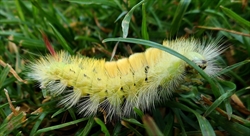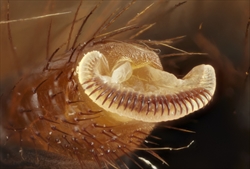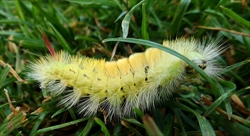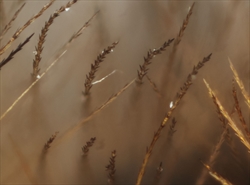Underwings, Litter Moths, Tiger Moths, Lichen Moths, Wasp Moths, Tussock Moths, Piercing Moths, Micronoctuoid Moths, Snout Moths, Zales, and others
Background
The recently erected lepidopteran family, the Erebidae, is part of the superfamily Noctuoidea, and is now one of the largest moth families. It contains several well-known groups such as the tiger moths and tussock moths. The adults range from very small in the Micronoctuini (Hypenodinae) to the often large Erebinae. This family is ubiquitous and contains many agricultural pests. The family is very varied and is difficult to define on both adult and larval morphology. Similar to many of the Noctuidae, the caterpillars of many species are adapted to an arboreal lifestyle and have become semi-loopers (Fig. 1), with a reduction or loss of prolegs on some or all of abdominal segments three to five. Mature larvae are usually apparently smooth caterpillars but the well-known Arctiinae (tiger moths) and Lymantriinae (tussock moths) (Fig. 3) are notably hairy and bristly. Caterpillars of both of these subfamilies acquire poisonous chemicals from food plants, which may be retained in the adult as defence. Many larvae also are heavily armoured with urticating and barbed setae.
The Erebidae can be most easily confused with the Noctuidae and Geometridae. All three families include caterpillars that can be classified as loopers, with varying degrees of proleg loss and reduction, although most Geometridae, by far, have lost prolegs on A3-A5. Looper caterpillars in the Erebidae and Noctuidae are commonly called ‘semi-loopers’ to differentiate them from geometrids (see information below on separating loopers form semi-loopers). Geometrid larvae are not ‘hairy’ caterpillars unlike many in the Erebidae (esp. Arctiinae and Lymantriinae (Fig. 3)) and Noctuidae (esp. Acronictinae and Pantheinae) as mature geometrid larvae very rarely have secondary setae, which, when present are confined in small numbers to the prolegs. Primary setae are usually also short in mature geometrid caterpillars.
A diagnosis of the Erebidae and descriptions of subfamilies are provided below. The largest and most economically important subfamilies are the Aganainae, Arctiinae, Calpinae, Erebinae, Herminiinae, Lymantriinae and Scoliopteryginae.
The current 18 subfamilies are listed as follows. A short explanation of recent taxonomic changes is appended to relevant groups.
Subfamilies
- Aganainae (tropical and subtropical areas of the Old World) (formerly placed in the Noctuidae and Arctiidae, and a separate family prior to that)
- Anobinae Formerly the Anobini and was a tribe within the Catocalinae (Noctuidae) and Calpinae, respectively.)
- Arctiinae – tiger, lichen, and wasp moths (formerly a separate family)
- Boletobiinae
- Calpinae – piercing moths (previously under the Noctuidae)
- Erebinae – underwings and kin (previously a noctuid subfamily, the Catocalinae)
- Eulepidotinae
- Herminiinae – litter moths (previously treated as a separate family, the Herminiidae, or as a subfamily of the family Noctuidae)
- Hypeninae – snout moths (previously under the Noctuidae)
- Hypenodinae (Strepsimaninae) (includes the Micronoctuini)
- Hypocalinae
- Lymantriinae – tussock moths (formerly a separate family)
- Pangraptinae
- Rivulinae (previously classified as part of the subfamily Hypeninae of Erebidae, or within Noctuidae)
- Scolecocampinae (not found in Australia)
- Scoliopteryginae – piercing moths (previously included in the subfamily Calpinae of the family Noctuidae)
- Tinoliinae (not found in Australia)
- Toxocampinae
Short Description
Semi-loopers vs Loopers
Looper caterpillars are those that move by alternatively arching and straightening their bodies, much like a leech, to move quickly along the substrate. This form of movement is usually accompanied by the loss or reduction of prolegs on abdominal segments A3-5 (Fig. 1) and is most likely an adaptation for ease of movement in arboreal habitats. The prolegs on A6 and A10 act as clamps securing the caterpillar to the substrate while it moves around or stays stationery. Loss of prolegs also contributes to camouflage such as twig mimicry. Looping is most characteristic of the family Geometridae, which are also known as inchworms. However this morphological adaptation has also occurred convergently in noctuoid families, most notably the Erebidae, Noctuidae and Nolidae. In these, looping caterpillars are known as semi-loopers distinguishing them from the geometrid loopers. Consequently, it is sometimes difficult to differentiate caterpillars from these different families but the following points should aid in the identification process:
- All loopers (including semi-loopers) show either reduction or loss of prolegs on abdominal segments A3-A5 (Fig. 1).
- An important point of difference between geometrid and noctuoid loopers is that the A5 proleg is similar in size to the A6 proleg (Fig. 1) in the latter, but in the vast majority of cases is smaller in geometrids (but see the Geometridae fact sheet).
- The presence of four lateral setae on the abdominal segments is diagnostic for geometrid caterpillars. There are only three other groups known that have this extra L seta in caterpillars, the Acronictinae and Dilobinae in the Noctuidae, and the Arctiinae in the Erebidae. However none of these non-geometrid caterpillars are semi-loopers. Thus loopers can be separated from semi-loopers on the presence of this extra lateral seta. Also, both Acronictinae and Arctiinae are hairy caterpillars with abundant secondary setae, immediately separating them from geometrids.
- Nolid semi-loopers, only, have reduced or no prolegs on A3 with that of the A4 fully developed. Additionally all nolid larvae have secondary setae, which means they cannot be confused with geometrids, or any semi-looper noctuids with prolegs reduced on absent from A3.
Description
Adapted from Stehr et al. (1987), Holloway (1998), Kitching & Rawlins (1998) and Zahiri et al. (2012).
Erebid caterpillars are very variable and difficult to characterise. They range in form from the hairy, ‘woolly-bear’ caterpillars of the Arctiinae (tiger moths) and Lymantriinae (tussock moths) Fig. 3), to stout, patterned and smooth larvae of many other subfamilies. Semi-loopers occur across the family (Fig. 1).
The Diagnosis lists characteristic features of the Erebidae. The trisetose condition of the SV setae of the first abdominal segment is listed first, as this is diagnostic for the Erebidae and for most of the Noctuoidea, but differentiates these groups from the Noctuidae. The rest of the characters are only partially diagnostic for the family, only occurring in certain subfamilies. This information is noted in the text below each character.
Diagnosis
- Setae
- A1 SV
- Trisetose in the Erebidae. This is a diagnostic difference between Erebidae and Noctuidae with only a few known exceptions. The vast majority of species in the so-called quadrifine subfamilies of Noctuoidea (Nolidae, Euteliidae, Erebidae) have three SV setae here.
- Bisetose in some Calpinae and Herminia (Herminiinae) (lacks SV2 on both A1and A2), but other known herminiine larvae are trisetose on both these segments. Most Noctuidae have bisetose setae on A1.
- A1 SV
- Prolegs on A3-A6
- Fully developed in the Lymantriinae, Arctiinae
- Fully developed or slightly reduced in the Aganainae, Herminiinae. In Herminiinae, many species have a full complement of prolegs, but in several genera (e. g. Idia) there is reduction in a manner convergent with other quadrifine noctuids.
- Loss of prolegs on A3 and A4
- Erebinae. In Mochis and Caenurgina (both in Euclidiini)
- Reduced or absent on A3 and A4
- Erebinae. In Achaea, at least in the Indo-Australian species; A3 is more reduced than A4.
- Hypeninae (Fig. 1)
- Hypenodinae
- Rivulinae. e.g. In Oglasa and Oxycilla, but fully-developed prolegs on abdominal segments A3-A6 in Rivula.
- Crochets
- Heteroideous (Fig. 2). In Arctiinae and Calpinae (e. g. Scoliopteryx and Gonodonta). This generally distinguishes the Arctiinae from the Noctuoidea but all Syntomini and some Lithosiini (Stehr et al. 1987) in the Arctiinae have homoideous crochets.
- Homoideous in all other subfamilies.
- Plantae extended laterally (boat-shaped) (Fig. 2). In the Arctiinae (frequently). Plantae in the Ufeini (Noctuidae: Noctuinae) and in the Collomeninae (Nolidae) (on A5 and A6 in the latter) are also exceptionally large.
- Setae
- A1-A2, SV group
- A1-A6 - subprimary seta vertically below D2. In Calpinae (Anomiini and Gonopterini (e.g. Scoliopteryx))
- A1-A7 - extra seta below D2. Unique to the Scoliopteryginae.
- A3-A6, extra L seta (L group quadrisetose). Diagnostic for the Arctiinae. This can only be observed in genera that only have primary setae, e.g. Tyria, Utetheisa, Amerila and Nodozama, all in the Arctiini, but not in larvae with multisetose verrucae. Also in the Acronictinae and Dilobinae (both Noctuidae)
- T2 and T3
- D1 and D2 pinacula often fused into a single verruca. Diagnostic for the Arctiinae. May be similar to the condition in the Acronictinae and Dilobinae (both in the Noctuidae) in which the dorsal pinacula are often fused over T2 and T3.
- SV group
- Bisetose. In Arctiinae. Also bisetose in the Glottulini (Noctuinae) some Plusiinae and Dyopsinae (all Noctuidae).
- Unisetose. In Aganainae. Considered synapomorphic for the Noctuinae.
- Abdomen - seta MSD
- Absent. In Arctiinae but only in the Lithosiini and Syntomini. A synapomorphic condition unknown elsewhere in the Noctuoidea.
- Hair tufts or pencils
- A1-A4 with dense, dorsal hair brushes. In Orgyiini (Lymantriinae) (Fig. 3)
- Barbed setae
- Hollow, barbed, urticating setae. In Lymantriinae (some) e.g. Euproctis (Nygmiini)
- Barbed and/or plumose setae arising from verrucae (Fig. 4). In Arctiinae. Some species of Lithosiini lack verrucae and have a single seta arising from pinacula (Fig. 5). The following species belonging to the Arctiini only have primary setae and lack verrucae: Tyria, Utetheisa, Amerila and Nodozama.
- Long barbed setae. In Rivulinae – but probably only Rivula.
- On T1 and sometimes A9, a pair of directed loose tufts, with a similar mid-dorsal tuft on A8. In Orgyiini (Lymantriinae).
- Setae on raised chalazae. In Hypeninae. The larval setae are usually borne on raised chalazae although these are often not conspicuous in later instars. Rivulinae – but probably only in Rivula.
- Secondary setae
- Present
- In Lymantriinae – abundant, with paired multisetose verrucae (Fig. 3).
- In Arctiinae – abundant, arising from verrucae. In Arctiinae. However, some species of Lithosiini lack verrucae and have a single seta arising from pinacula (Fig. 5). The following species belonging to the Arctiini only have primary setae and lack verrucae: Tyria, Utetheisa, Amerila and Nodozama.
- Absent
- Generally, in other sub-families
- Present
- T2, with more than one verruca above the spiracle. In Arctiinae. Except only one above the spiracle in the Ctenuchina (Arctiini). This feature is also in Acronicta and Diloba (Noctuidae: Dilobinae)
- Tubercles
- A pair of dorsolateral tubercles on A8. In Erebinae. Hair tufts or pencils
- Patterns
- Often with black patches between the abdominal prolegs. In Erebinae, e.g. Thyas.
- Mouthparts
- Stipital lobes – large and well-developed. In Lymantriinae. Equalling or exceeding in size those of the Notodontidae.
- Glands
-
- A6-A7 – mid-dorsal glands, often yellow to red, or if abdominal segment 6 is without a gland, then abdominal segment 8 with a large, mid-dorsal hair pencil (Fig. 3). Characteristic of the Lymantriinae.
- A single gland on A6, occurs in some Calliteara (Orgyiini) (occurs in Australia) (e.g. C. pudibunda or pale tussock (Fig. 3), ubiquitous, but not found in Australia), while externally developed gland openings may occur on as many as six abdominal segments in other genera.
- Adenosma (larval ventral cervical gland, arranged ‘vertically’). Only in Lymantriinae, but only in several tropical genera. Also present in some genera of Pantheinae (Noctuidae). Absent in all known Arctiinae and Aganainae.
-
- Integument
- Spicules absent. Characteristic of the Arctiinae. A difference between Arctiinae and similar ‘hairy’ noctuids.
- Spinose. In Herminiinae
Detailed Description
Adapted from Stehr et al. (1987) and Kitching & Rawlins (1998).
Usually moderately large larvae with hypognathous heads, generally lacking secondary setae and not appearing hairy (Fig. 1), except for caterpillars belonging to the Arctiinae and Lymantriinae. The abundant secondary setae in both these subfamilies arise from verrucae. The body is typically cylindrical and stout (Fig. 1, Fig. 3, Fig. 5). Prolegs vary widely in development from a full complement with well-developed prolegs, to a loss and/or reduction in size on A3 and A4 (Fig. 1). Erebid semi-loopers can be differentiated from geometrid loopers on the relative size of the A5 and A6 prolegs. In geometrids, the A5 prolegs are smaller than A6 prolegs, whereas in erebids they are very similar in size (Fig. 1). Hairy erebids, namely the Arctiinae and Lymantriinae, have fully-developed prolegs on A3-A6 (Fig. 3). Crochets are usually a homoideous mesoseries, except in the Arctiinae and some Calpinae, which are heteroideous (Fig. 2).
Head: Usually hypognathous. The frontoclypeus is normally triangular. The adfrontal ecdysial lines are close to the frontoclypeal margins. There are six stemmata, with 1-4 in a semicircle with variable spacing and 5 and 6 removed from the 1-4 semicircle with an imaginary line extending through 5 and 6 not passing through the semi-circle. The stipital lobes are large and well-developed in the Lymantriinae.
Thorax: The prothoracic shield is usually well formed, but may be indistinct if the same colour as the rest of the body (Fig. 1).
T1: the setae XDI and XD2 are positioned near the anterior margin and D1 and D2 are close to the posterior margin of the shield but in Rivula (Rivulinae) D1 and D2 are closer to the anterior margin. SD1 and SD2 are close to each other and SD1 is usually thinner than SD2 but only one SD seta is present in some Herminiinae. L1 and L2 arise close to each other, anterior of the spiracle. L2 is usually thinner than L1 but only one L seta is present again in some Herminiinae. SV1 and SV2 are present above the leg.
T2 and T3: D1, D2, and SD2 insertions lie in an approximate straight line; SD1 is usually hairlike, and situated below and usually separate from SD2. L1, L2, and L3 are present. The SV group is usually unisetose, except bisetose in the Arctiinae. In the Arctiinae the D1 and D2 pinacula are often fused into a single verruca.
Abdomen: D1 and D2 are present. D1 is dorso-anterior of D2 on A1-8. On A9 D1 is ventro-anterior of D2. SD1 is dorsad and SD2 anterior of spiracle. SD2 is absent on A9. The L group has three setae on A3-6 except for the Arctiinae in which there are four. L1 is directly posterior of the spiracles on A3- A6 but is usually ventroposterior of the spiracle on A7. The SV group has three setae on A1 except in the Calpinae and Herminia, in which there are two. In the Herminiinae (except Herminia) the SV group is trisetose on A1 and A2. The A9 has only one seta in the L group. The MSD seta is absent in the Arctiinae. The suranal shield is present but is not always conspicuous.
The Erebinae frequently have a pair of dorsolateral tubercles on A8. Black patches between the abdominal prolegs are also often a feature of this subfamily. Reduction and loss of prolegs occurs widely across the subfamily (Fig. 1), except in the hairy erebids, the Arctiinae and Lymantriinae, which have a full complement of fully-developed prolegs. Crochets are homoideous but heteroideous in the Arctiinae and Calpinae (Fig. 2). The plantae are often extended in the Arctiinae (Fig. 2).
Secondary setae are abundant in the Arctiinae and Lymantriinae. Hair tufts and pencils are present on A1-A4 in the Lymantriinae (Orgyiini) (Fig. 3). Barbed setae arising from verrucae occur in both the Arctiinae (Fig. 4) and Lymantriinae; in the former, there is more than one verruca above the spiracle on T2. However the lichen-feeding Lithosiini (Arctiinae) lack verrucae (Fig. 5). Rivula (Rivulinae) has long barbed setae. Setae arising from raised chalazae are characteristic of the Hypeninae, but are not always apparent in mature larvae. In the Aganainae, the larvae may appear hairy because of the long primary setae arising from chalazae. Integument is usually devoid of spicules but is often spinose in the Herminiinae.
Abdominal glands are characteristic of the Lymantriinae. Mid-dorsal glands, which are often yellow to red are often present on A6-A7. The A6 gland may be replaced with a large mid-dorsal hair pencil on A8 (Fig. 3). Gland openings can also occur on as many as six abdominal segments. A ventral cervical gland, arranged ‘vertically’, termed the adenosma, can also be present in several tropical lymantriine genera.
Spiracles are generally elliptical, with those on T1 and A8 generally larger than those on A1-A7.
Species of Biosecurity Concern
THE FOLLOWING SPECIES IS OF BIOSECURITY CONCERN TO NORTHERN AUSTRALIA
Subfamily Lymantriinae
Characteristics of the Lymantriinae
- A single, mid-dorsal, eversible, often yellow to red gland on segment A6 and usually A7, or if abdominal segment 6 is without a gland, then abdominal segment 8 bears a large, mid-dorsal hair pencil (Fig. 3). Characteristic of this sub-family.
- Abundant secondary setae. Body usually with series of dorsal hair tufts or pencils, with paired multisetose verrucae (Fig. 3). Similar to the ‘hairy’ noctuids, Acronictinae and Pantheinae and notodontids (e.g. Datana), and the Arctiinae.
Other Characters
- Adenosma present in several tropical genera. A ventral cervical gland, arranged 'vertically'.
- Large and well-developed stipital lobes. In many mature larvae. Equalling or exceeding in size those of the Notodontidae.
- Hollow, barbed, urticating setae. In some (esp. Euproctis (Nygmiini)
- Many feed on arboreal hosts. In some species, the newly hatched larvae feed in protected aggregations; their bodies are covered with toxic scales formerly deposited on the egg cluster.
Lymantria ninayi (Lymantriinae: Lymantriini) (tussock moth)
Description
This species of tussock moth is restricted to Papua New Guinea. It is a major pest species of forests.
There is very little useful published information readily available on this species. However, there is information and photos of the species on the following website: http://www.fzi.uni-freiburg.de/InsectPestKey-long%20version/lymaninay.htm
Biology and Feeding Damage
In pine trees, younger larvae attack young needles, with mature larvae consuming older needle, causing defoliation.Current Distribution
- Papua New Guinea
Caterpillar Host Plants
- pine trees (Pinus)
- Casuarina
References
Holloway, J. D. (1998) The classification of the Sarrothripinae, Chloephorinae, Camptolominae and Nolinae as the Nolidae (Lepidoptera: Noctuoidea). Quadrifina Band 1: 247-276.
Kitching, I. J. & Rawlins, J. E. (1998) Noctuoidea. Handbook of Zoology. Lepidoptera, Vol. 1: Systematics and Evolution (ed. by N.P. Kristensen), pp. 355–401. W. de Gruyter, Berlin.
Stehr, F.W., Martinat, P.J., Davis, D.R., Wagner, D.L., Heppner, J.B., Brown, M.E., Toliver, M.E., Miller, J.Y., Downey, J.C., Harvey, D.J., McFarland, N., Neunzig, H.H., Godfrey, G.L., Habeck, D.H., Appleby, J.E., Jeffords, M., Donahue, J.P., Brown, J.W. & Frack, D.C. (1987) Order Lepidoptera, pp 288–596. In Stehr, F. W. (Ed.), Immature Insects. Kendall/Hunt, Dubuque.
Zahiri, R., Holloway, J.D., Kitching, I.J., Lafontaine, D., Mutanen, M. & Wahlberg, N. (2012) Molecular phylogenetics of Erebidae (Lepidoptera, Noctuoidea). Systematic Entomology, 37: 102–124.





